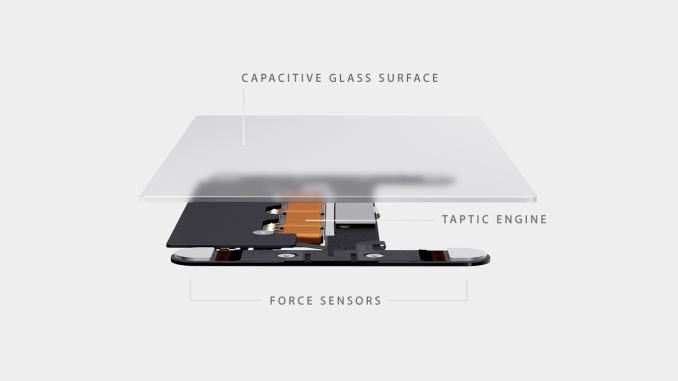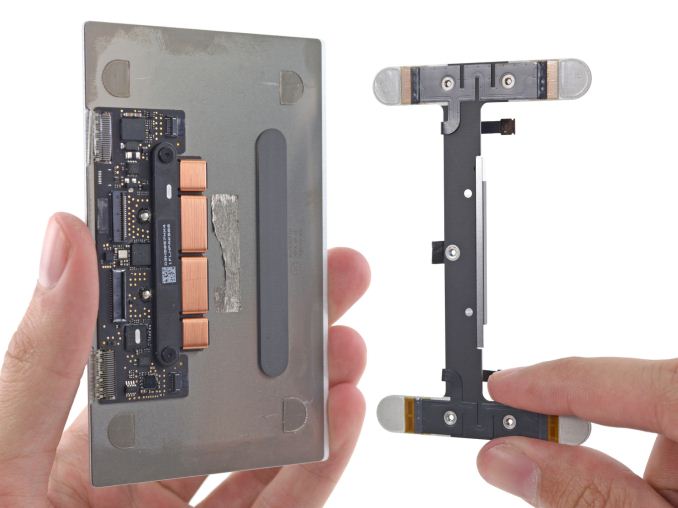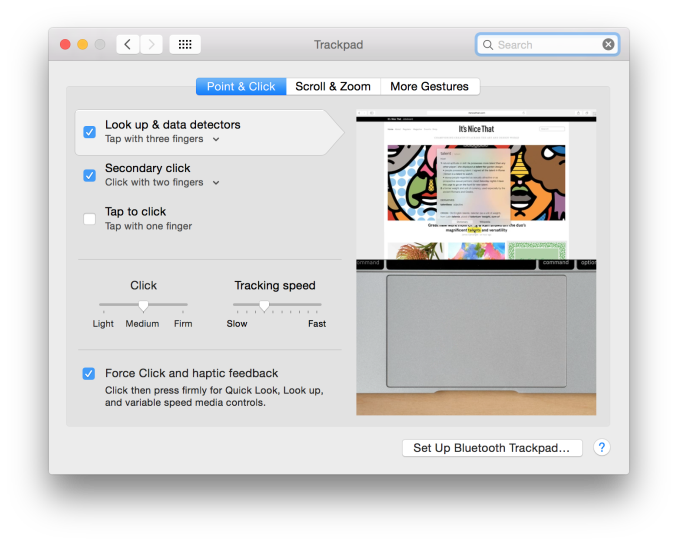The 2015 MacBook Review
by Ryan Smith on April 14, 2015 10:15 AM ESTForce Touch Trackpad
Along with Apple’s changes to their keyboard, the company has also gone in and significantly reworked their trackpad. The new Force Touch Trackpad represents the biggest change to Apple’s trackpad design since the creation of the capacitive, multi-touch pivoting trackpad introduced on the unibody MacBook Pro. In putting together the Force Touch Trackpad, Apple has significantly reworked the internals of the trackpad, creating a trackpad that behaves a lot like their traditional trackpad with some new features, but under the hood relies on some very different mechanisms.
The big change here is that Apple has done away with the traditional pivot and switch mechanism. With pivot and switch, the capacitive trackpad surface would act like a small touchscreen, and underneath it was a switch to register when the trackpad was pressed down. Mechanically the trackpad pivoted from the top (Apple likes to compare it to a diving board), with the trackpad inferring what action to take based on the combination of the capacitive readings and the switch reading. Multi-finger gestures would rely solely on the capacitive layer, primary/secondary clicks would be based on the number of fingers in use when the switch was actuated, etc.
The Force Touch Trackpad on the other hand eliminates the pivot and switch mechanism in favor of a combination of an electromagnet and force/pressure sensors. The pressure sensors essentially replace the physical switch, allowing the trackpad to tell when it has been pressed based on the amount of pressure, and thanks to the pressure sensors it can now tell how hard it has been pressed as opposed to the binary nature of the physical switch. Meanwhile without a physical switch in place to provide the clicking sensation and feedback of pressing down on the touchpad, Apple’s electromagnet – the Taptic Engine – activates to simulate the feeling and noise of pressing a switch.
Update 04/15/2015: iFixit has a great shot of the trackpad's internals, including a good look at just how big the electromagnet/taptic engine really is.
The end result is that the MacBook’s trackpad is among the first wave of devices that ships with Apple’s next generation trackpad and the enhanced capabilities that go with it. Ignoring the pressure sensitivity for a moment (we’ll get back to it), replacing the pivot and switch for an electromagnet works shockingly well. From a touch & feel standpoint the Force Touch Trackpad feels virtually identical to a traditional trackpad, to the point where it’s more than a bit uncanny. In practice you are not actually triggering a switch nor is the trackpad really moving (technically it’s deforming ever so slightly), but it sure feels like you’re working a switch. Apple has clearly done their homework on getting an electromagnet to emulate a switch, to great results. Meanwhile they don’t have the trackpad’s acoustics precisely matching a switch, but the resulting pinball-machine like plunk is close enough to a click that I don’t imagine anyone will mind the difference.
One side benefit of this change is that the trackpad feels the same throughout, and unlike the pivoting trackpad does not require more or less force depending on where you are relative to the pivot point. The variable force required has never been a major problem in my experience, but it is nice to no longer need to worry about where your fingers are relative to the top, and consequently how much force you need to use.
However the bigger deal is that by making the amount of force required to click consistent throughout the entire trackpad, Apple can now use the amount of pressure applied as another input, making the trackpad pressure-sensitive. The underlying pressure sensors and electromagnet are by default programmed to have two levels of feedback – a shallower press is equivalent to a click – and a deeper press brings about the pressure-sensitive “Force Click.” What force clicking does depends on the application, and right now it’s clear that Apple is still experimenting with what they can do with pressure sensitivity. The most obvious uses include line thickness in drawing applications, but the company is also using it for things such as variable speed fast forward and rewinding in QuickTime/iMovie. At times the force click is treated like a 3rd (tertiary) click, and other times the result is based on variable pressure. Since this is a new (and uncommon) feature there’s no global action assigned to the force click – nor does it behave as a middle click on a regular mouse – so what happens is up to the application.
In implementing force click and the Force Touch Trackpad, Apple does offer the ability to control the amount of pressure required and whether force click is active. With force click deactivated the trackpad behaves more or less identical to a traditional trackpad with a single click level. Meanwhile the click pressure setting is interesting, though I’m not entirely convinced it’s all that effective. Short of the tools to actually measure click pressure, I’m not so sure Apple is changing the amount of pressure required to trigger a click so much as they’re changing how hard the electromagnet vibrates. The feedback change is certainly very subtle going from light to firm, and if there is a change in the amount of pressure required then it is certainly equally subtle.
Ultimately whether the Force Touch Trackpad is a major upgrade or not is going to depend on a user’s ability to make use of the force click features. Even turned off, the new trackpad is essentially an improved version of the old trackpad without the minor drawbacks of the pivot mechanism. But with the force click turned on, then it brings new (though not always useful) actions to the trackpad that in turn makes it a bigger upgrade over the old trackpad.
In any case, the MacBook along with the 2015 MacBook Pro 13” are the first wave of devices to implement the new Force Touch Trackpad. Given its expanded capabilities I would expect Apple to eventually replace many (if not all) of their trackpads with this new design. Certainly the 15” MacBook Pro is a likely candidate, as is a future version of the Magic Trackpad. What remains to be seen is whether the next MacBook Air also gets this new trackpad, or if Apple withholds it to keep the products differentiated and to keep the costs of the MacBook Air down.














354 Comments
View All Comments
sweenish - Tuesday, April 14, 2015 - link
Netbooks were a bit too miserable at the time. I wouldn't say this is the definitive line blurring device. I'd give that to the SP3.But this device is thin. Apple always impresses me with their hardware.
Impulses - Tuesday, April 14, 2015 - link
Netbooks weren't *that* bad at launch, relatively speaking, Atom was a lot better than the first gen VIA/etc stuff on the earliest netbooks... Problem is Intel sandbagged Atom and it stood still for years, took a few years until they even put out a mobo chipset that wasn't a total power hog and more appropriately matched Atom. OG Atom didn't launch in the Core i3/5 era, it just had to live on well into it before Intel woke up.Krysto - Tuesday, April 14, 2015 - link
$1300 netbooks FTW!mike55 - Tuesday, April 14, 2015 - link
Still not as expensive as this one: http://imgur.com/H1AhaY9TVC2 - Tuesday, April 14, 2015 - link
One thing that qualifies it as a "cross-over" is the 16x10 screen. Taller screens are part of the secret sauce that makes pads so useful; fear of letterbox (which is really bonus screen area) makes small laptops less useful without making them any easier to carry. Netbooks were just for surfing and checking mail. Jobs refused to build one - the iPad came out and netbooks went away.orthorim - Wednesday, April 15, 2015 - link
It's neither a Netbook nor a crossover. But a crossover would imply that it's in some way similar to a tablet, which it is not. This one comes with OS X, has a keyboard, and a USB port - it's not an appliance, it's a computer.I am thinking about it as a replacement for my retina MacBook Pro 15" but I think the screen is probably too small. Performance-wise I think it should be OK for programming - even if Xcode will doubtlessly bring it to its knees, as it seems to be able to do with any computer.
As for a pro computer needing massive CPU horsepower - that's a myth. Most of your daily tasks are going to be constrained by solid storage speed or internet speed, not by CPU speed.
Unless you're gaming (hardly a "pro" activity I may add), or encoding videos or rendering 3D, you don't need a quad core i7.
Things that have maxed out my CPU lately:
- Bad Apple software. Photos doing its face detection on my entire library for what seemed like an eternity
- Bad other software. Popcorn Time thanks to using a framework for video that seems even less efficient than Flash on the Mac, which is an achievement of sorts.
- Re-encoding Video. I do this so infrequently that I can probably live with it taking way longer.
eanazag - Wednesday, April 15, 2015 - link
I am totally happy to see Apple go with a 16 x 10 screen. I'd like all manufacturers to go this route.vampyren - Thursday, April 16, 2015 - link
hehe exactly :Dmrloadingscreen - Monday, April 20, 2015 - link
I don't know how you do it in the back there, but we don't call them lilmoes we call them "douche bags."blackmagnum - Tuesday, April 14, 2015 - link
"It was foretold by our forebears (circa 2013) that within this decade, the MacBook and the iPad would mate and produce an offspring."